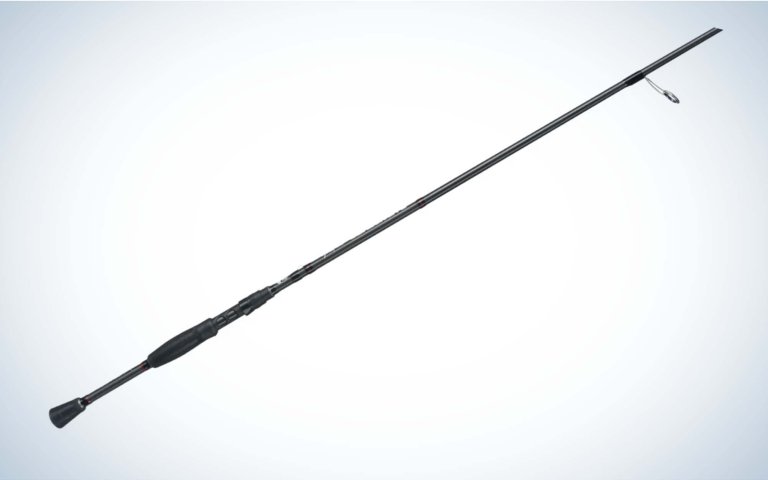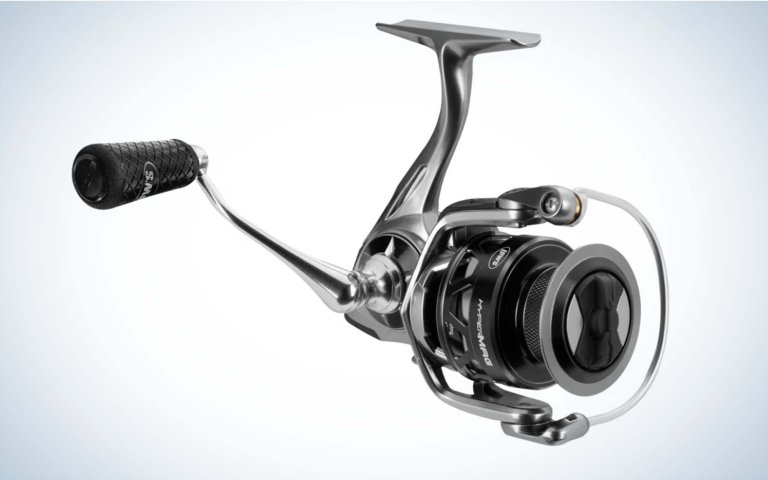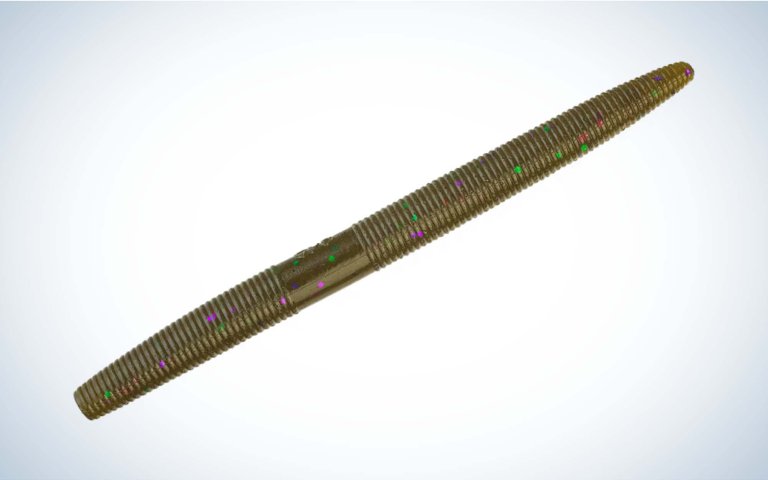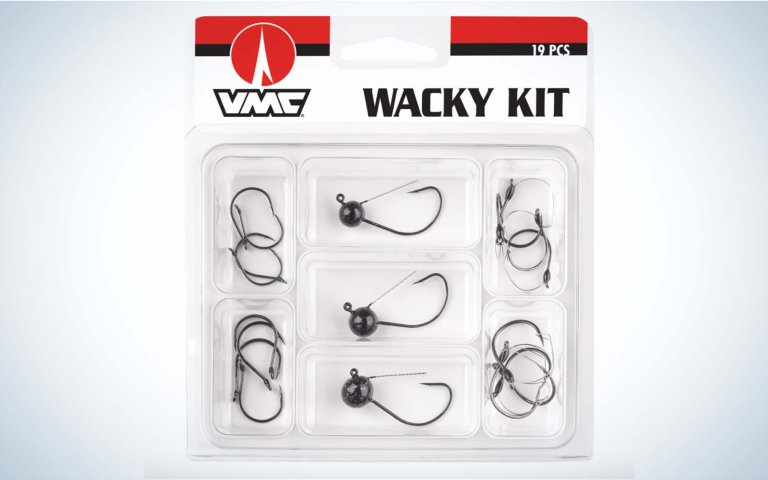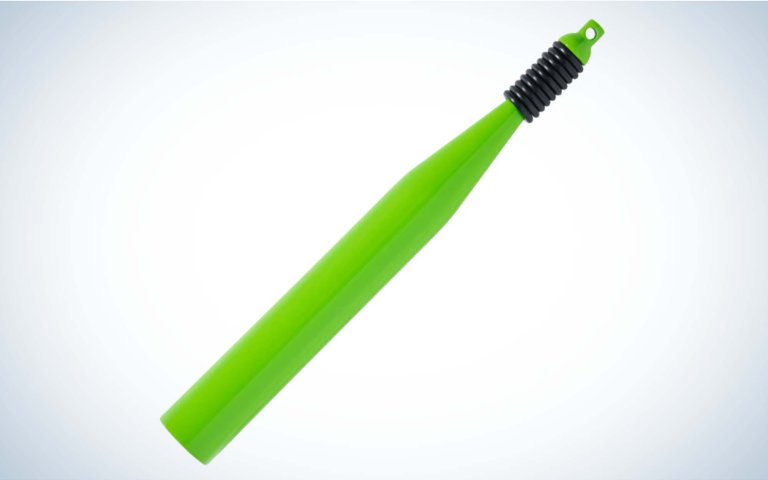We may earn revenue from the products available on this page and participate in affiliate programs. Learn More ›
A wacky rig is perhaps the most subtle, natural, and non-invasive presentation bass anglers use. It’s a very slow and finessed presentation unlike a crankbait or chatterbait.
But the true beauty of the wacky rig is that bass will bite it regardless of the conditions. They’ll bite a wacky rig when the bite is wide open, and when they won’t eat anything else. It doesn’t matter what mood the fish are in; they can’t resist the slow sinking wiggle of a wacky rig.
Whether you’re fishing boat docks, laydowns, grass lines, or rock piles, having a wacky rig tied on and ready to deploy is a must. Here’s everything you need to know about fishing a wacky rig.
The Wacky Rig

The standard wacky rig is a 2/0 octopus-style hook rigged through an O-ring that’s been placed in the center of a 4- or 5-inch stick bait. While the O-ring isn’t always necessary, it’s helpful in prolonging the life of your stick bait. O-ring or not, the wacky rig works so well because it’s simple. As the bait slowly sinks through the water column both ends of the stick bait shimmy, driving bass nuts.
How to Rig a Wacky Rig

A wacky rig should take no more than 30-seconds to be ready to fish. The longest part of the process is attaching the O-ring to your stick bait of choice. Below is a step-by-step guide.
Step 1: Select your hook. Some offerings include weed guards, which can be helpful when fishing around grass and heavy cover.
Step 2: Take your stick bait of choice and slide it into an O-ring tool. With this tool, you’ll simply slide the O-ring down the shaft and place it in the middle of your stick bait.
Step 3: Thread your hook between the O-ring and stick bait.
Step 4: Using a Palomar knot, tie your line to the hook.
What Makes the Wacky Rig Effective?

There are a lot of baits and lures out there that are made to catch fishermen rather than fish. As you walk down the aisle at your favorite tackle shop, you’ll see exactly what I’m talking about. Topwater baits with flapping arms and spinners, jerkbaits with blades on the back treble, and lures that imitate animals like rats and ducks. While some of those baits may work in certain situations, oftentimes they’re more than you need.
A wacky rig is the exact opposite.
Its simplicity makes it arguably the most effective soft plastic fishing technique to ever exist. The subtle, slow-sinking shimmy tugs on a bass’s instincts and triggers them to feed. Whether they believe the stick bait is a baitfish, a leech, or even a snake, they can’t resist the action of a wacky rig.
Bass are ambush predators, and they often stage near cover like dock pilings, laydowns, and grass lines waiting for unsuspecting prey. The wacky rig seems to trigger their ambush reflex as it slowly sinks near the cover. The reason is in the action.
In my opinion, the wacky rig represents a dying baitfish. The slender profile resembles a shad, and the shimmy of the stick bait as it falls on a slack line looks exactly like a baitfish sinking through the water column — wiggling its head and tail simultaneously.
For a deep dive on the wacky rig, check out this great video from my friend Flukemaster.

How to Fish a Wacky Rig
Since the wacky rig is such an effective technique no matter the time of year, there are plenty of options when deciding how to fish the rig. The water temperature and general feeding attitude of the bass will be the best way to decide if you should be adding more action to the rig, or simply let it fall naturally on a slack line.
In cold water, a natural, slack line fall is likely the most effective way to fish it. It’s important to try to match any bait you’re fishing to how natural baitfish present, and in colder temps, the baitfish are lethargic. So the slow, subtle fall of a slack lined wacky rig is a great way to replicate that action.
When the water temperatures rise, however, and the bass flood to the bank to ambush their prey around shallow cover, adding action to your rig can make all the difference. By lightly jigging your rod tip, you can add a flurry of action to the soft plastic, causing an erratic darting action rather than a slow, methodical fall. In warmer water temps, the baitfish tend to dart in and around cover a lot more, so the light jigging and the action it introduces to your rig is the perfect way to trigger bass into biting.
Typically, either dead sticking or lightly jigging your wacky rig will be enough to get some bites, but if you find yourself fishing a wacky rig in schools of baitfish suspended over deep water, another option is to swim the wacky rig just below the surface. While it might seem counterintuitive, this wacky rig technique seems to shine during feeding frenzies where bass are gorging themselves on a school of bait held over deep water. The swimming wacky rig has just enough action to stand out to the frenzied bass, giving them an easy target to hone in on and inhale.
No matter how you choose to fish your wacky rig, it’s important to keep an open mind and be willing to try introducing different actions to the bait throughout the day. You never know, you might just find a special motion with the rod that becomes a mainstay in your wacky rigging technique.
When to Throw a Wacky Rig
If you’re trying to decide when to throw a wacky rig, ask yourself this simple question: Am I fishing for bass? If the answer is yes, regardless of the time of year, a wacky rig will get you bites.
Now, as with all year-round techniques, there is a prime-time to fish a wacky rig, and to me, that’s the post-spawn. In the post-spawn, bass get lethargic. They’re recovering from the spawn and they don’t have the energy to go offshore and chase schools of baitfish in deep water. Typically, once the spawn ends, the bass head to the first piece of cover they can find in 8 to 12 feet of water to recuperate and feed on easy prey.
That’s why fishing a wacky rig during the post spawn around dock pilings and laydowns can be some of the best fishing you’ll experience all year. The wacky rig is an easy meal for tired bass. It’s similar to running a marathon and being offered a cheeseburger 30 minutes after you cross the finish line. You probably can’t resist.
Another reason as to why the wacky rig is a go-to during the post-spawn is that there are plenty of bass still in the shallows guarding their fry. When your bait approaches the small school of baby bass, the fry-guarding bigger bass will treat the bait like an intruder and eat it to protect their offspring. It’s not often that you’ll have the rod ripped out of your hands when fishing a wacky rig, but this is one of those times.
The Best Wacky Rig Rod Setups, Baits, and Gear

Here’s the rod, reel, line, hooks, baits, and O-ring tool you’ll need to fish a wacky rig.
Picking the Right Rod
When faced with selecting the right rod for your wacky rig, you’re in luck. Most of the best spinning rods will do the trick. If you have a favorite spinning rod for fishing light Texas rigs or weightless worms, then you probably don’t need to go shopping. But, if you’re looking to upgrade to the perfect wacky rig rod, look no further than the Bass Pro Shops Johnny Morris CarbonLite Wacky Rig spinning rod. At 7 feet, 2 inches and a medium action, this rod is specifically designed for making long, accurate casts with a wacky rig. It’s got a stiff enough backbone to make sure the fish is hooked well, but a soft enough tip to make sure they don’t come off during the fight.
Picking the Right Reel
Similarly to the rod you choose, your reel can be just about any of the best spinning reels you have in your arsenal. But, if you’re looking for the perfect wacky rig reel, I would recommend going with a lightweight spinning reel that offers a high-speed gear ratio. That will be important for quickly picking up the slack in your line after you feel the bite to ensure a good hook set. For me, the Lew’s HyperMag Magnesium spinning reel in a size 200 is the perfect choice.
Baits
In my experience, the saltier the stick bait, the longer they’ll hold on after a bite. With that in mind, I’ve almost exclusively used a Gary Yamamoto Senko. The high salt content in their soft plastic stick bait just seems to add more action and increases the fall rate when compared to some other stick baits. If you’re looking for another option to add to your stick bait arsenal, I’ve also had some great luck with a Berkley PowerBait MaxScent The General Worm. While the salt content might not be quite as high, the addition of the MaxScent can sometimes be the ticket, especially when fishing more heavily pressured bodies of water.
As far as the size of your stick bait goes, picking between a 4- or 5-inch bait is all you really need. I personally prefer the 5-inch options as they tend to offer more action, but will go with a 4-inch bait if I’m fishing a smaller pond or lake that offers smaller baitfish. Always try to match the size of your bait to the typical baitfish in the body of water.
Hooks
The hook you decide to use for your wacky rig is critical. While there are plenty of options out there, I’ve always had luck with the 2/0 TroKar weedless wacky worm hooks. I prefer the weedless option as I’m typically fishing a wacky rig around heavy cover, laydowns, or docks that are surrounded by grasses like hydrilla and milfoil. The weedless hook might not keep every strand of grass off, but every little bit helps.
Another great option in wacky rig hooks for folks trying to step up their terminal tackle game is the VMC wacky rigging kit. The kit offers regular wacky hooks, weedless hooks, and even weighted wacky hooks for deep water applications.
O-Ring Tool
The O-ring is an optional addition, but one that I tend to lean on as it extends the life of my bait. There isn’t much to the O-rings themselves, but getting them on the stick bait without an O-ring tool can be taxing. My favorite O-ring tool is the Bass Pro Shops Floating Quick Rigger Tool. The fact that it floats sold me on it, and it works exactly how it’s supposed to.
Line
The last piece of gear you’ll need is the line on your reel. Avid bass anglers often fish spinning reels with a braid-to-fluorocarbon leader. For my braided line, I like to go with 10-pound Daiwa J-Braid, but most braided lines will do the trick. As for the fluorocarbon leader, I lean on 8-pound Sunline FC.
Final Thoughts
Throwing a wacky rig is never a bad option. There are plenty of professional bass anglers that still rely on a wacky rig over the course of a four-day tournament to get much needed bites to cash checks. If the pros are using it, that’s a good sign that you should follow suit. Tie one on and it won’t let you down.

